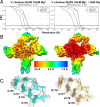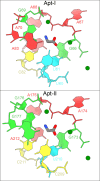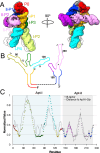This is a preprint.
Cryo-EM reveals remodeling of a tandem riboswitch at 2.9 Å resolution
- PMID: 40343338
- PMCID: PMC12060979
- DOI: 10.21203/rs.3.rs-6422592/v1
Cryo-EM reveals remodeling of a tandem riboswitch at 2.9 Å resolution
Abstract
Riboswitches are non-coding RNA sequences that control cellular processes through ligand binding. Conformational heterogeneity is fundamental to riboswitch functionality, yet this same attribute makes structural characterization of these mRNA elements challenging. Here, we use a combination of molecular dynamics and cryo-electron microscopy to expound the flexible nature of the glycine riboswitch tandem aptamers and characterize diMerent structural populations. We find that Mg2+ partially stabilizes the fully folded state, resulting in one-third of the particles adopting a unique "walking man" conformation, consisting of a rigidified core and two dynamic helices, and two-thirds adopting distinct, partially folded states. Glycine interactions double the relative population of fully folded particles by stabilizing a conserved inter-aptamer Hoogsteen base pair, enabling our capture of a 2.9 Å structure for this RNA-only system. The population data show that glycine and Mg2+ operate synergistically: glycine enhances Mg2+ occupancy, while Mg2+ drives glycine specificity. Our findings indicate that cryo-electron microscopy oMers a promising avenue to characterize RNA folding ensembles.
Conflict of interest statement
Additional Declarations: There is NO Competing Interest.
Figures













Similar articles
-
Regulatory context drives conservation of glycine riboswitch aptamers.PLoS Comput Biol. 2019 Dec 20;15(12):e1007564. doi: 10.1371/journal.pcbi.1007564. eCollection 2019 Dec. PLoS Comput Biol. 2019. PMID: 31860665 Free PMC article.
-
Ligand binding by the tandem glycine riboswitch depends on aptamer dimerization but not double ligand occupancy.RNA. 2014 Nov;20(11):1775-88. doi: 10.1261/rna.047266.114. Epub 2014 Sep 22. RNA. 2014. PMID: 25246650 Free PMC article.
-
Modulation of quaternary structure and enhancement of ligand binding by the K-turn of tandem glycine riboswitches.RNA. 2013 Feb;19(2):167-76. doi: 10.1261/rna.036269.112. Epub 2012 Dec 17. RNA. 2013. PMID: 23249744 Free PMC article.
-
Linking aptamer-ligand binding and expression platform folding in riboswitches: prospects for mechanistic modeling and design.Wiley Interdiscip Rev RNA. 2015 Nov-Dec;6(6):631-50. doi: 10.1002/wrna.1300. Epub 2015 Sep 11. Wiley Interdiscip Rev RNA. 2015. PMID: 26361734 Free PMC article. Review.
-
Computational Methods for Modeling Aptamers and Designing Riboswitches.Int J Mol Sci. 2017 Nov 17;18(11):2442. doi: 10.3390/ijms18112442. Int J Mol Sci. 2017. PMID: 29149090 Free PMC article. Review.
References
Publication types
Grants and funding
LinkOut - more resources
Full Text Sources

